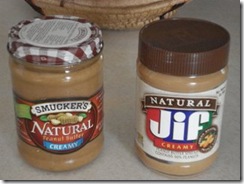 What do you think when you see the word “natural” on a food label? I think, “Great! Nothing’s been added to the main ingredient.”
What do you think when you see the word “natural” on a food label? I think, “Great! Nothing’s been added to the main ingredient.”
I have preferred “natural” peanut butter for several years. That’s ground-up peanuts with nothing added except salt. The two brands that have been available to me bear the Smucker’s and Kroger labels. [They contain 150 mg. and 120 mg. of salt per serving respectively. I might like it even better without the salt.]
“Regular” peanut butter typically adds not only salt but hydrogenated oils and sugar.
Knowing my preference, my husband recently brought home some Jif Natural Creamy Peanut Butter Spread. The words spread and contains 90% peanuts were the first clue that maybe this wasn’t what I considered “natural.” Sure enough, added to peanuts on the list of ingredients were sugar, palm oil, and 2% or less of molasses and salt.
A Google search led me to Snack Girl‘s post on the subject. According to her research, the only difference between Jif Natural and Jif regular peanut butter is the absence of hydrogenated oil. The problem with that, however, is that although they haven’t hydrogenated the oils in the peanut butter to give it extra shelf life, they have used palm oil, which is naturally hydrogenated!
This is one more example of why you can’t trust the front label on processed foods. They are packaged to sell the ingredients. “Low fat” may mean added sugar, and “sugar-free” may indicate added fat. If we want to eat more food and less poison, we must read the ingredients and nutrition labels.
Have you found any “false labeling” lately?

My favorite misleading label is “wheat” bread. Hmmmmm….. I thought it was ALL (mostly, anyway) wheat bread, even if it’s white and pillow-soft. They’re trying to imply, of course, that it is “whole-wheat” bread. This is one product you always have to check the ingredients for the first one listed. Actual whole wheat bread is more rare than you think. I’ve even been fooled by the “7-grain” label, which implies a lot healthier product than is sometimes the case.
Thanks for your input, Yvonne.
Coincidentally, the TOPS magazine I received yesterday featured an article entitled “Fighting Fake Food Claims,” which talks about “value-added foods,” like juice with added fiber, diet sodas with vitamins added, “immunity-boosting foods,” even butter with omega-3 added. One of the sub-heads is “Natural Means Nothing.”
It’s a ploy to make us think we’re eating healthier without having to substantially change our eating habits. Unfortunately, it works. Fortunately, they can’t mess with the nutritional content on the back of the package. It’s up to us to read it.
I bought a Jar of Great Value no stir Natural peanut butter spread. I thought great, Natural. But when I took a bite and then read the label, no way it’s Natural. Why are they aloud to put that on the label? False advertising to me .